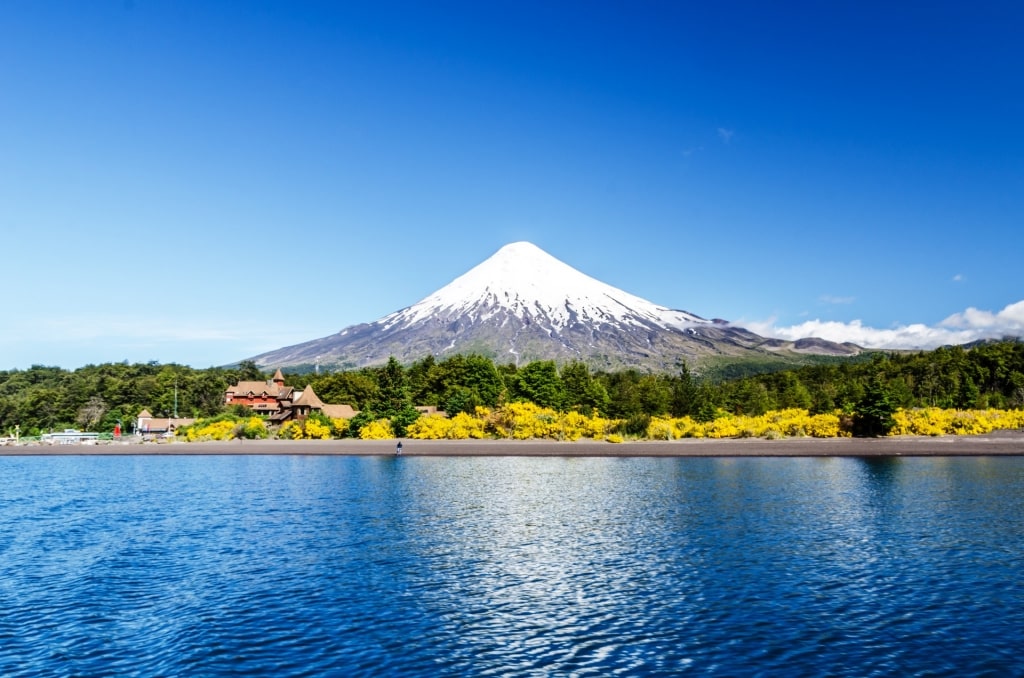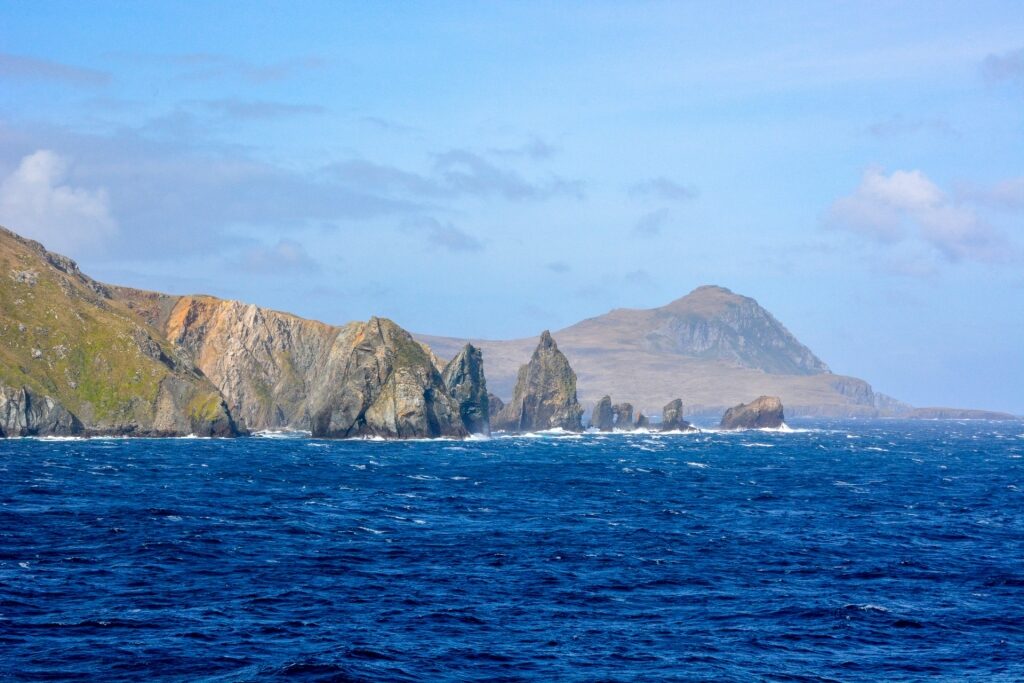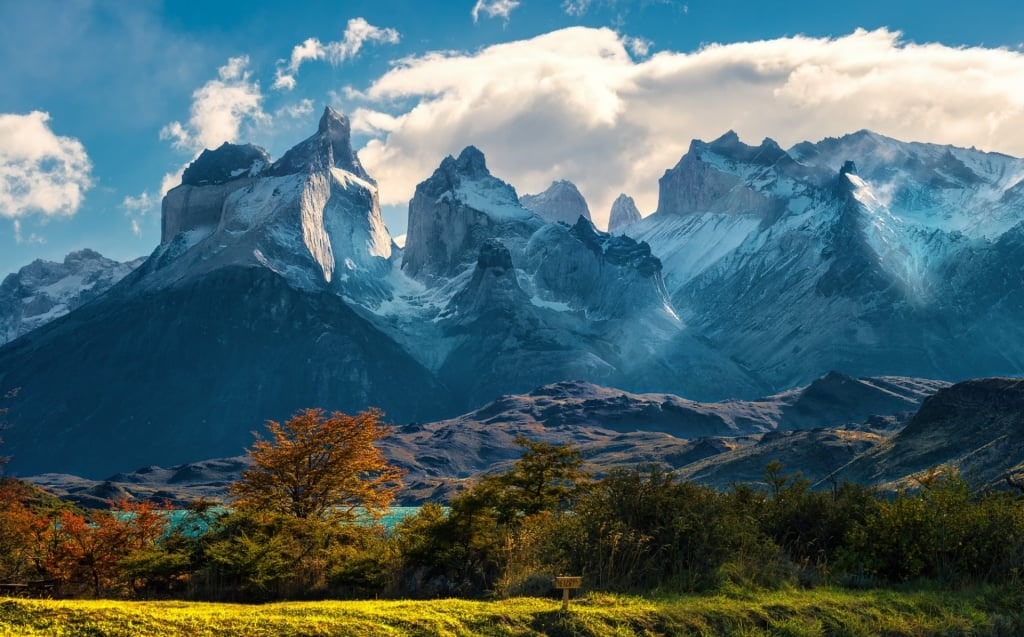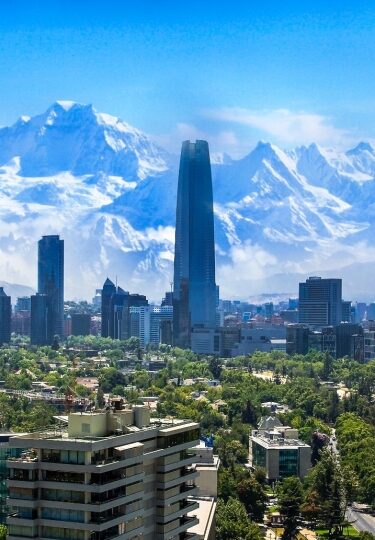The best time to visit Chile is in the summer—that is, between November and February. But with 4,000 miles of coastline and climatic zones ranging from desert to high mountains, this long, skinny country understandably experiences extremes of climate.
In the far north, the Atacama Desert is hot and dry, while windswept Cape Horn, the country’s southern tip, is cool and blustery, even on its finest days. Travel to the capital, Santiago, in summer, and you’ll enjoy wonderfully long, warm summer days, the snowy peaks of the Andes dominating the horizon.
As Chile is in the Southern Hemisphere, its seasons are reversed from those of the north. So midsummer is December, while the coldest months, and the peak of the winter sports season, are June and July.
Visiting Chile By Season

Osorno Volcano
Summer
November to February is summer in Chile. Temperatures in Santiago, which enjoys a Mediterranean climate, range from 79°F to 84°F (26°C to 29°C), with minimal rainfall.
The Lake District, around Puerto Montt, is often bathed in sunshine in summer, although temperatures are lower here, from around 61°F to 66°F (16°C to 19°C) by day.
Being a desert, the Atacama enjoys consistent temperatures year-round, averaging around 75°F (24°C) in summer. January is an anomaly in that it’s the month of highest rainfall, up to nearly one inch (24mm), when all other months have virtually no rain.
Punta Arenas, due to its far southerly location, is never particularly hot, but daylight hours are long in summer. Expect temperatures of 53° to 57°F (12°C to 14°C). Brace yourself for strong winds here; there’s almost always a stiff breeze, and November is the windiest month.
Torres del Paine National Park in Patagonia is at its busiest now, although everything is relative and there are still vast swathes of wilderness in this mountainous region; this season is the best time to go to Chile for hiking.
If you’re traveling around Patagonia on a clear day, look out for the strange lenticular clouds hanging over the mountains. Resembling saucer-shaped UFOs, they’re common in this part of Chile.
Fall
Between March and May, temperatures slowly drop in Santiago, although you’ll still enjoy daily averages of around 66°F (19°C) in March, a great time to visit Chile. By May, though, there’s a fair bit of rainfall in the capital, up to 2 ½ inches (64mm).
In the Lake District, temperatures remain mild in fall, and the colors on the trees are magnificent. By around May, there’s heavy rainfall, with a monthly average of 9 ½ inches (241mm). The far south, around Patagonia, has less rain, but much lower temperatures, hovering just above freezing point.
Winter
Unless you’re here for winter sports, or traveling in the Atacama desert to the north, your options in Chile in winter are limited. This is a time of snow in Patagonia and heavy rain in the Lake District. In Punta Arenas, in the far south, June sees around seven hours of daylight.
Spring
Between September and November, temperatures in Santiago creep up to 79°F (26°C) once more, with low rainfall. Temperatures in Valparaiso on the coast are just a couple of degrees lower, the vines in the Casablanca Valley fuzzy with emerald-green spring growth.
The Lake District takes longer to warm up, being much further south, but can be beautiful on a clear spring day, the volcanoes still capped with snow.
If you visit Patagonia early in the season, expect temperatures in single figures. Thermals and waterproofs are essential if you’re planning on hiking.
When is Rainy Season?
Rainy season in Chile doesn’t necessarily correspond with latitude, as you might expect. May to July is the wettest time in Santiago, with 3 ½ inches (93mm) average rainfall in July and August and heavy snow in the mountains. On clear days, the views from the city of the jagged Andes, draped in snow, are magnificent.
The Lake District, too, is at its wettest between May and July, with a whopping 9 ½ inches (241mm) of rain expected in May.
Patagonia, though, has its wettest months in fall, in March and April, when up to 4 ½ inches (115mm) of rain is expected, falling as snow on high ground.

Cape Horn
When is High Season?
High season in Chile is generally from November to February, when the days are long and the temperatures higher. This is the best time to visit Chile if you want to head all the way south, to the wild beauty of Patagonia, the shimmering lakes, and the solitary beauty of Cape Horn.
In Santiago, you could be basking in temperatures of 86°F (30°C), with balmy nights. The vineyards between the city and the coast are lush and green, and the beaches at Valparaiso are busy with vacationing locals.
November is a wonderful time to explore Patagonia, before the summer peak. Summer, too, is the best time to visit Cape Horn, where the mighty waves of the Atlantic and the Pacific meet, and the next stop over the horizon is Antarctica.
In February, the Lake District is popular with Chileans escaping the heat of the cities for hiking, lakeside retreats, and outdoor life.
When is Shoulder Season?
October, March, and April are generally regarded as shoulder season. In March and April, the leaves turn on the vines in the Casablanca Valley between Santiago and the coast, and celebrations abound around the grape harvest.
Snow may already be falling in the Torres del Paine National Park, where temperatures could drop to freezing point. However, wildlife can still be spotted, from guanacos (a relative of the llama) to puma. The colors on the trees are still brilliant here, in hues of scarlet and ochre.

Torres del Paine National Park
When is Low Season?
Unless you’re a skier, June to August is low season. City dwellers head for the Andes during these months for winter sports, and temperatures on the coast around Santiago are around a steady 59°F (15°C). But the south of the country is cold during winter, with limited daylight hours.
Would you like to discover Chile’s wild beauty for yourself? Browse our cruises to Chile and find the perfect itinerary.


